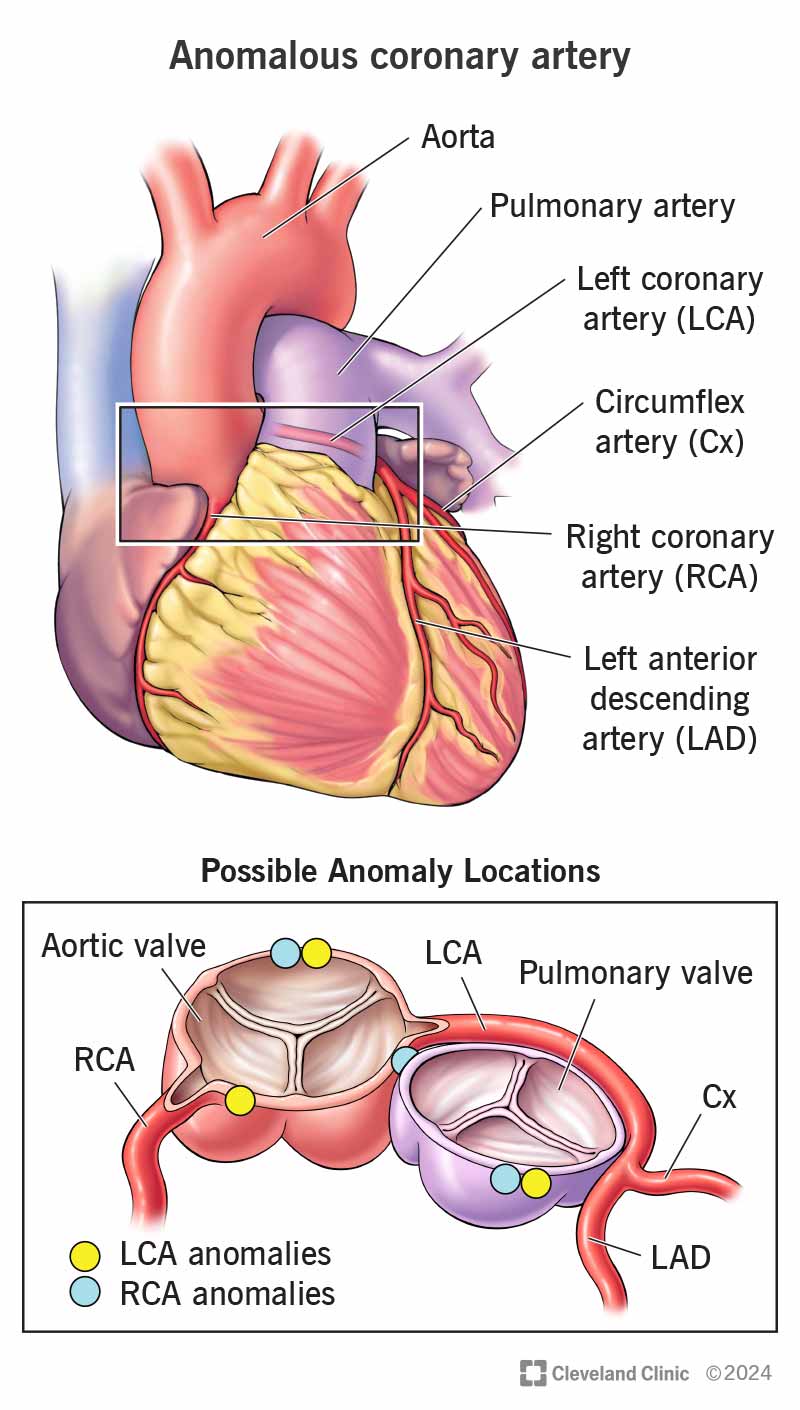An anomalous coronary artery wasn’t formed correctly in the uterus. This rare problem means your coronary artery is in the wrong spot or it started in the wrong spot. This can cause problems with how your blood circulates through your heart. When your heart muscle doesn’t get the oxygen it needs, tissues can die.
Advertisement
Cleveland Clinic is a non-profit academic medical center. Advertising on our site helps support our mission. We do not endorse non-Cleveland Clinic products or services. Policy

An anomalous coronary artery is one that didn’t form correctly before birth. In many cases, the coronary artery is in the wrong place or is coming from the wrong place. This problem can affect your child’s:
Advertisement
Cleveland Clinic is a non-profit academic medical center. Advertising on our site helps support our mission. We do not endorse non-Cleveland Clinic products or services. Policy
The problem with anomalous coronary arteries is that they aren’t where they’re supposed to be. They may start in:
When one of your child’s coronary arteries is in the wrong place, it disrupts the normal way blood flows through their heart. This can keep oxygen-rich blood from getting to their heart muscle.
Up to 1% of the population has an anomalous coronary artery. Most cases aren’t dangerous. But occasionally, anomalous coronary arteries can lead to insufficient (not enough) blood flow to your heart muscle.
Types of anomalous coronary arteries include:
Advertisement
In some cases, the normal coronary artery can make up for what the abnormal coronary artery can’t do. This is why some people don’t have symptoms until they’re adults.
Anomalous coronary artery symptoms may differ based on the type of issue.
Many children with this type don’t have symptoms. Sudden cardiac arrest or sudden cardiac death during exertion may be the first sign of it. This may happen between ages 10 and 30. The risk of problems also depends on which specific coronary artery is anomalous.
Symptoms for this type include:
Symptoms for this type may show up at birth or between ages 40 to 60. Symptoms may include:
Symptoms often show up in a baby’s first year. They include:
Children or adults with ALCAPA can have:
Anomalous coronary artery causes are unknown. An anomalous coronary artery is a congenital (present at birth) problem. This happens to a fetus during its first month or so in the uterus when the coronary arteries are forming.
Researchers haven’t found evidence that an anomalous coronary artery is hereditary.
Complications of an anomalous coronary artery may include:
Making an anomalous coronary artery diagnosis can be difficult because someone with the condition can have a normal physical exam. Also, some people don’t have symptoms.
Tests for anomalous coronary artery include:
Providers recommend surgery for certain people (with or without symptoms) with anomalous origin of the left coronary artery. But they only suggest it for some of those who have an anomalous origin of the right coronary artery with symptoms. Most adults with anomalous origin of the right coronary artery don’t need surgery.
If surgery isn’t a good option, a provider may recommend limiting your child’s physical activity. They also may prescribe medicines like diuretics or beta-blockers to ease their heart’s workload. Your child will only need to limit their physical activity if their anomaly puts them at risk of cardiac arrest.
Advertisement
Many people without symptoms, especially young and healthy people, choose to have surgery to prevent possible problems with their coronary arteries.
Surgeries for an anomalous coronary artery include:
Complications of surgery may include:
Surgery has a small risk of death.
Your child may be in the hospital for several days after surgery and may need to take aspirin for three months. They should be able to go back to sports activities three months after surgery.
Since an anomalous coronary artery is present at birth, that won’t change unless your child has surgery. They’ll need to get regular medical checkups throughout their life. Their provider will repeat the tests they used when they diagnosed your child.
If your baby has ALCAPA and doesn’t receive treatment, there’s a 90% chance it will be fatal. In a small number of cases, people grow to be adults with or without symptoms. The outlook is good if a provider treats ALCAPA before problems happen.
Advertisement
For AAOCA, surgery gets rid of symptoms and protects your child from sudden death. Limiting physical activity also may prevent sudden death. The risk of problems depends on whether the anomalous artery is the right coronary artery or one of the left-sided coronary arteries.
Unfortunately, you can’t prevent an anomalous coronary artery because it’s a condition that’s present at birth.
If your child is waiting to have surgery or if surgery isn’t a good option for them, their provider may ask you to limit their exercise. If they’re considered low-risk, they may not need surgery and can be as physically active as they want to be.
If your child is at risk for cardiac arrest, consider learning CPR and getting an automated external defibrillator (AED) for home use. Knowing how to respond to a cardiac arrest can provide peace of mind for your family.
Contact your provider when your baby:
If you’re an adult, you should go to the ER when you’re having chest pain and shortness of breath.
Questions to consider asking your provider may include:
Advertisement
Finding out that your child has a heart issue can bring on a range of emotions. The good news is that an anomalous coronary artery usually isn’t harmful. Talk about your child’s situation with their provider. They can recommend what your child needs. Be sure to keep taking your child for regular checkups and tests as needed.
Whether you were diagnosed as a child or later in life, Cleveland Clinic is here to treat your adult congenital heart disease.

Last reviewed on 12/03/2024.
Learn more about the Health Library and our editorial process.